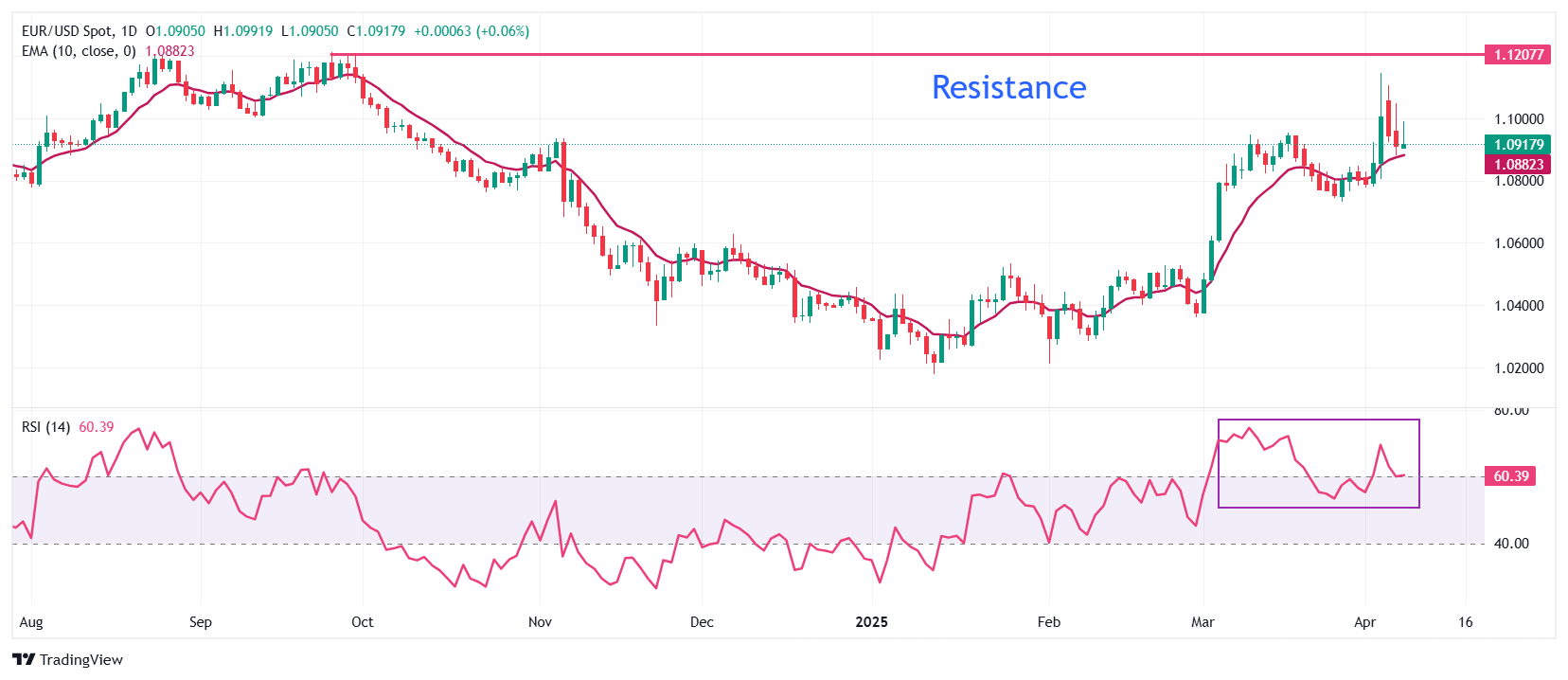-
EUR/USD remains under pressure while attempting to reclaim the 1.1000 level, as investors await the Eurozone finance ministers' meeting to address potential responses to Trump’s tariff threats.
-
President Trump has warned of an additional 50% tariff hike on China in retaliation for Beijing’s countermeasures to last week’s reciprocal levies.
-
The Federal Reserve is widely expected to cut interest rates in June.
EUR/USD trades modestly higher during Tuesday’s European session but struggles to reclaim the critical psychological level of 1.1000. The currency pair remains in a tug-of-war for further gains as the US Dollar Index (DXY) attempts to extend its two-day rebound beyond Monday’s peak of 103.50.
The US Dollar is broadly under pressure following President Donald Trump’s announcement of fresh reciprocal tariffs last week. In a bid to address trade imbalances and reinforce his "Make America Great Again" agenda, Trump introduced a sweeping 10% universal baseline tariff, escalating trade tensions with major US trading partners.
Concerns are mounting in financial markets that this new wave of tariffs, along with likely retaliatory measures, could tip the global economy into recession. On Monday, Trump warned of an additional 50% tariff hike on Chinese imports unless Beijing withdraws its retaliatory 34% tariffs on US goods, set to take effect Thursday. In response, China’s Ministry of Commerce condemned the US tariffs as “a mistake on top of a mistake” and vowed to “fight to the end” to protect its interests.
These developments have increased expectations for a Federal Reserve interest rate cut at the June policy meeting. According to the CME FedWatch tool, market participants are now largely confident that the Fed will lower borrowing costs to cushion the impact of rising trade tensions.
Looking ahead, investors will turn their attention to the US Consumer Price Index (CPI) and Producer Price Index (PPI) data for March, due Thursday and Friday, respectively, for further clues on inflation and monetary policy.
Daily Market Movers: EUR/USD Gains as Dollar Weakens
- The EUR/USD pair continues to benefit from US Dollar weakness, though the Euro’s outlook remains clouded by fears of a full-blown trade war between the Eurozone and the US. Investors are closely watching developments as Eurozone finance ministers prepare to meet in Warsaw on Friday to discuss the EU’s response to Trump’s escalating tariff threats.
- Ahead of the meeting, Polish Finance Minister Andrzej Domański cautioned that disrupted supply chains and higher costs could weigh on European growth and consumer sentiment. He warned of “adverse social consequences” and “higher prices” that could hurt European households.
- Meanwhile, European Union Trade Commissioner Maroš Šefčovič revealed that the EU has proposed a “zero-for-zero” tariff deal with the US on cars and industrial goods—an offer seen by investors as a positive sign for potential de-escalation. However, the Euro remains under pressure due to increasing dovish signals from the European Central Bank (ECB). Key ECB officials, including Italy’s Piero Cipollone, France’s François Villeroy de Galhau, and Greece’s Yannis Stournaras, have all voiced support for further policy easing.
- Stournaras emphasized that the inflation path remains unchanged despite trade tensions, and reaffirmed that US tariffs would not hinder the ECB’s expected April rate cut. He estimated the tariffs could reduce Eurozone GDP growth by 0.3%–0.4% in the first year. On Tuesday, Stournaras reiterated the need for a less restrictive policy in 2025, though he acknowledged that rising inflation could delay the normalization of monetary policy.
Technical Analysis: EUR/USD Struggles at 1.1000

From a technical perspective, EUR/USD remains capped below the 1.1000 barrier during European trading hours. The pair found support on Monday at the 10-day Exponential Moving Average (EMA), currently around 1.0883, and has since rebounded modestly.
The 14-day Relative Strength Index (RSI) hovers near 60.00, indicating that bullish momentum is still in play.
On the downside, key support is seen at the March 31 high of 1.0850, which could act as a floor if bearish pressure resumes. To the upside, a break above 1.1000 could open the door for a test of the September 25 high at 1.1214—a significant resistance level for Euro bulls.





